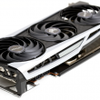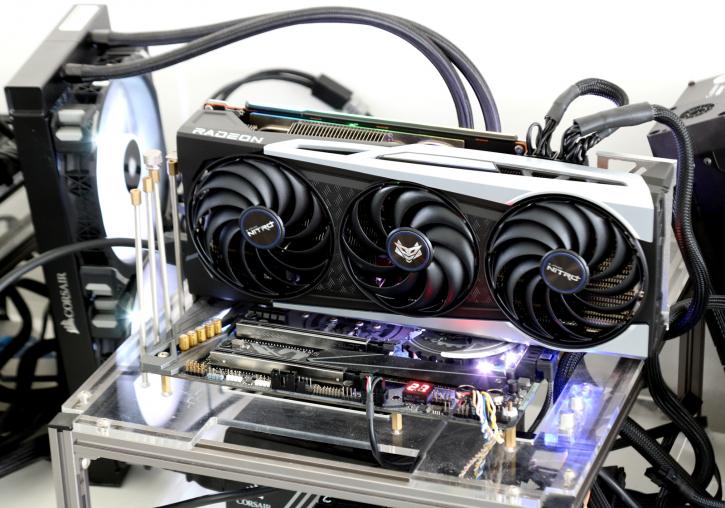Final words and conclusion
Final words
Sapphire has released a solid card here, decent acoustics, decent temps, and of course, a new level of performance for AMD users to look out for with a dash of Raytracing to fiddle and fool around with. AMD outed their 6800 series in November 2020, and aside from a miserable launch availability wise, the cards did manage them to be where they need to be, which is NVIDIA territory. Technologies like raytracing are now becoming a norm for gaming. With Big Navi, aka the 6800 and 6900 series, AMD is back to the table with a deck of cards that offers support for that full DirectX Ultimate feature set. Not just that, they've made some big bets with the architecture. The infinity cache definitely brings them where they need to be performance-wise. You can see that the L3 cache hit rate works really well for them in 1920x1080 up-to 2560x1440. However, at Ultra HD, these cards slow down a notch, likely due to GDDR6 memory being tied top that 256-bit wide memory bus and thus gets bandwidth deprived. But even there, the cards remain extremely capable.
Performance
Ultimately everything and anything it's all about gaming price, performance, and, of course, rendering quality. Of course, the Radeon RX 6800 XT is a product that ticks the mandatory boxes. We do feel the 6800 offers more value for money. This card can run games at 4K; it will serve extremely well at WQHD and with brutally GPU bound games. At Full HD, you'll be quite often bottlenecked and CPU limited, but compared to NVIDIA's RTX 3080 and even 3090, AMD's L3 cache brings them some speedy performance. Competition wise you're looking at 3080 levels of performance for the 6800 XT overall. Performance-wise we can safely state that this is a true Quad HD graphics card that is very Ultra HD capable of the current games. AMD's biggest deficit, however, is that they do not have a solution at hand that matches DLSS from NVIDIA. The added Tensor cores in hardware on the RTX series will always work out better for NVIDIA. Even with DirectML support pending, these still need to be run over the compute engine. So no matter how we look at it, it'll cost performance, whereas NVIDIA can offload its ML supersampling to the tensor cores. It's the sole reason why they implemented these specific DL/AI cores in the first place.
Smart Access Memory
You will have noticed that AMD introduced SAM, smart Access memory. And it's a feature to keep an eye on as the results have shown IF it kicks in, it can boost your framerates significantly. Out of the three games tested, only one kicked in, but extremely well; Assassins Creed: Valhalla absolutely loves this feature. As explained, it does come with compromises, as SAM requires that CSM Support is turned off in the BIOS to enable above 4G Decode, which will allow Resizable Bar Support (SAM) to be enabled. The problem here is that if your Windows installation is configured as non-UEFI, Windows will be unable to boot from your currently installed SSD/HDD (unless you try some very advanced trickery). Most PCs will be configured like that. The only solution is to disable CSM and reinstall Windows 10 to get this feature-set supported.
Raytracing
AMD performs reasonably at best, sometimes close and in line with NVIDIA but often at GTX 2080 Ti / RTX 3070 performance levels. We had hoped for a bit more bite as RT wise you'll be playing at WQHD at best, and there is where ML supersampling could have benefit AMD. What helps them is the Infinity cache, so overall, AMD is offering a fun first experience in Hybrid raytracing, but we expected more. If we look at full path Raytracing, then AMD lags significantly as the competition shows numbers nearly twice as fast.
Compute performance
Generic compute performance in application like VRAY show a good boost in performance. OpenGL performance is lagging badly; then again, who still uses it? AMD shines in D3D12 and Vulkan, less so on professional workloads.
Cooling & noise levels
The Nitro+ series offers good results in even stressed conditions; we hit close to 38 dBA acoustic values at 40cm distance. That's okay, as you will hear a bit of airflow. Temperatures are fine, however, they depend on the airflow level inside your chassis; you can expect the card to sit close to a 75 Degrees C range temperature-wise under hefty load conditions. FLIR imaging shows the card is hardly bleeding heat. Overall, we're very comfortable with what we observe.
Energy
Heat output and energy consumption are closely related to each other, as (graphics) processors and heat can be perceived as a 1:1 state; 250 Watts in energy consumption equals close to 250 Watts in heat as output. This is the basis of TDP. AMD is listing them at 250 (6800) to 300 (6800 XT) Watts for the flagship product, which is okay for a graphics card in the year 2020 at this performance level. We measure numbers to be close to the advertised values for the XT but closer towards 335 Watts.
Coil whine
The SAPPHIRE cards do exhibit coil squeal, but tiny amounts of it. Is it annoying? It's at a level you can hear it. In a closed chassis, that noise would fade away in the background. However, with an open chassis, you can hear coil whine/squeal. Graphics cards all make this in some form, especially at high framerates; this can be perceived.
Pricing
Limited availability and nauseating price levels these days for a graphic card are becoming bothersome. I mean, even for us true hardcore PC gamers, it's getting more and more difficult to explain why people should put down this much money to be able to play computer games on a PC. I mean, the spread is $999 for the 6900 XT, $649 for the 6800 XT, and $579 for the cheapest 6800 model. Sure, you can game at Ultra HD and get 16GB of GDDR6 memory, but with the new consoles from Microsoft and Sony in mind sitting at a 500 USD marker for their GPU, CPU, Storage, and hey the console as a package, we are getting more and more uncomfortable about the price levels for graphics cards. We do expect AIB cards to be more expensive, as that is a trend as of late. SAPPHIRE stages the NITRO+ at a rather steep 769 USD though. In EUR depending on country expect it to sit at 799 EUR. We'll have to wait and see how that pans out, though, as everything is dependant on the actual volume availability of these cards.
Tweaking
AMD is enforcing a cap again on the memory; we don't like that as we feel we could have gone a notch further. The tweaks on the clock frequency and memory run fine, but the performance was often lower than defaults. We expect you to reach ~17 GBps of effective bandwidth. Of course, increase the power limiter to the max, so your GPU gets (even) more energy budget. In the year 2020/2021, clock frequencies matter LESS than that power limiter. You could clock a GPU even at 3 GHz, but when a power limiter kicks in, it'll always bring down that frequency to match your power budget. Results will vary per board, brand, and even card due to cooling (GDDR6/GPU/VRM). So the power limiter is the decisive and dominant factor; lowering or increasing the power budget allows for higher framerates. That, combined with say 2500 MHz on the clock frequency (and we do expect some board to hit 2600 MHz), Is your magic tweak. But all that tweaking and extra energy consumption will bring you a max of ~6% extra performance at best seen from reference performance. The GPU gets memory bottlenecked at higher resolution due to the 256-bit design and GDDR6 choice in memory; ergo, here, a memory tweak will absolutely help. Overall we've been able to add 2% performance on top of the factory tweak that Sapphire applied. Our advice, leave it at stock settings as Sapphire tuned this card really well already.
Conclusion
Sapphire brings an interesting product to the table with the NITRO+ series. Not only do they offer good looks and are the metrics for acoustics and cooling on a suitable level, but they also perform a notch faster than reference as well. That does remain a tad relative, though, as, in the high-end spectrum, the margins for more performance and tweaking over the years have vanished a bit, as the players like AMD will try and get as much as they can from the products in that baseline configuration. Typically, tweaking margins were 15 maybe 20% years ago; these days, you're lucky to gain 5 to 10% overall. And within that thin margin, the AIB partners nab away from perf as well, with the factory tweaked products. So there is little more left, and most partners will perform quite close towards each other. All that is not perse a bad thing as it saves you the diligence of tweaking yourself. The NITRO+ is a sound product with obviously a nice amount of graphics memory compared to what NVIDIA is offering with the RTX 3070 and 3080. With future games in mind, this could turn out to your advantage as you can quite easily play Ultra HD games without running into VRAM limitations anytime soon. With Smart Access memory in mind, this helps out as well. Overall, the 3800 series performs better than we initially expected in the lower resolutions and offers expected performance when playing good old fashioned rasterizer engine games. If you are less interested in what Raytracing and DLSS bring to the table, then the 6800 XT with it's 16GB graphics memory is an easily recommended choice over the $699 GeForce RTX 3080 for 649 USD. But if that is reversed for you and you want maximum Hybrid raytracing performance, then AMD's miss is the lack of some hardware Tensor cores and a DLSS equivalent that is hardware-backed. As far as the NITRO+ goes, hey, we cannot complain here; it ticks all the right boxes and as such comes recommended. Now let's hope these products will actually become available in substantial enough quantities so that prices aren't hiked upwards, preventing you from singing 'all I want for Christmas is ...'. We'll happily grant a recommended award. Pricing, however, is steep, I mean reference costs 649 USD, this one 769 USD. That's what keeps it away from being a top pick award as otherwise, it's a really good graphics card.
Sign up to receive a notification when we publish a new article.
Or go back to Guru3D's front page
- Hilbert, LOAD"*",8,1.



